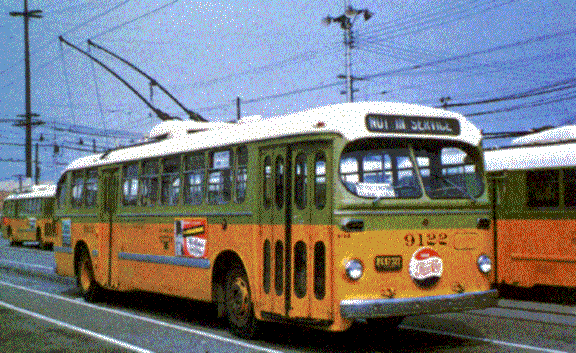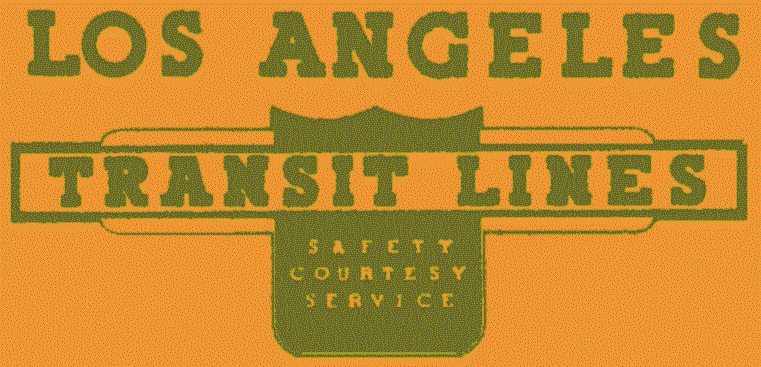
#9122 ACF Brill T-46 / GE 1213 - J1 electric. One of the final 30 delivered to Los Angeles in 1948.
Los Angeles Transit Lines - The Trolley Bus in Los Angeles

 1947-1963
1947-1963
Considering the fact that Southern California had been the site of the continent's first revenue trackless trolley line in the prehistoric year of 1910, the modern trolley coach was a long time coming to Los Angeles.
The Bungalowtown Line of the Laurel Canyon Utilities Company had operated in the Hollywood area and into the hills beyond from 1910 to 1915 in a section of the county which at the time was not within the Los Angeles city limits. It amounted to a five-year experiment in early trackless trolley technology, and not a particularly successful one at that. Those days were ones of great expansion in Southern California's transit network, but the streetcar and the interurban railway were preeminent.
The first substantial move away from the electric railway in Southern California had been in the direction of the motor bus, in the 1920s. Within the city of Los Angeles this was at least partially due to the fact that there were two companies operating the local rail lines -- the 3'-6" gauge Los Angeles Railway, controlled by Henry E. Huntington, and the standard gauge Pacific Electric Railway, owned by Southern Pacific Railroad.
Both companies contemplated the extension of rail service to the rapidly growing areas south of Hollywood, but a tacit agreement kept Huntington out of Hollywood itself. The threat of a well-financed outsider, none other than William Gibbs McAdoo -- famed New York subway builder, World War I administrator of the nation's railroads and adopted Californian -- to blanket Los Angeles with bus lines in the early 1920s forced the two railway companies to join together in a mutual defense pact; as The Los Angeles Motor Bus Company (later renamed L.A. Motor Coach), jointly owned and administered. The McAdoo-L.A. Motor bus controversy was settled at the polls in favor of L.A. Motor Bus in 1922 which proceeded to lay out a checkerboard of gas bus lines in the western area of the city. Thus the motor bus came to Los Angeles early, and in a substantial way.
In the 1930s Los Angeles Railway was one of the companies sponsoring the development of the PCC car, but financial difficulties prevented the firm from ordering more than enough cars to cover three principal routes. LARy did not seem interested in the trolley coach, although one of the Twin Coach units which barnstormed the West was demonstrated in 1937; in fact in 1940 LARy announced plans to adopt the diesel coach, just perfected for city service, as its primary transit vehicle on all routes except for the three enjoying PCC cars.
World War II upset LARy's plans. A few additional PCC cars were purchased under Office of Defense Transportation auspices, along with some new buses. Both LARy and PE were overwhelmed with commuting war workers.
It was the sale of LARy by the Huntington estate to National City Lines that brought the trolley coach to Los Angeles. NCL purchased LARy in 1945 and renamed it the Los Angeles Transit Lines. NCL under the leadership of one time railroad man E. Roy Fitzgerald had bought up dozens of small and medium sized transit companies in the late 1930s and almost without exception, quickly motorized them. General Motors, Mack Truck, oil and tire companies were among NCL's stockholders.
Yet the result of NCL's takeover in Los Angeles was a considerable slowing down of the previously announced motorization schedule. Forty additional PCC cars were ordered and plans were announced to install trolley coaches. The first fifteen TCs came from Oakland where another NCL property, Key System Transit Lines, had aborted the plans of the previous owners for a trolley coach network in that city.
There were those who suspected that NCL's sudden interest in electric vehicles in Los Angeles was inspired by the federal government's moves to indict the combine on anti-trust charges. This indeed came to pass and was successfully prosecuted in a Chicago trial.
On August 3, 1947, the nine-mile #3-West Sixth Street-Central Avenue Line was inaugurated as a trolley coach operation after a preview ride the day before with a delegation of movie starlets in attendance. The forty TCs on this route displaced street cars on the 'D' and 'U' routes. It was a heavily utilized line, peak hour headway was two minutes.
A second trolley coach line was established on December 5, 1948 when rail Line-'B' became trolley coach Line #2-City Terrace-Hooper Avenue. This line was 10½ miles long and required 36 vehicles.
The #3 Line was extended another 3.1 miles on September 10, 1950 up Wilton Place and west on Third Street to Fairfax Avenue replacing a portion of rail Line-'S'.
LATL acquired a total of 110 trolley coaches, all Brills, a number far in excess of its peak requirements. Nevertheless no other lines were converted although LATL made engineering studies with a view toward converting the five-mile #41-Alvarado Street crosstown motor bus route.
Pacific Electric meantime was never an apt candidate for trackless trolleys since most of its rail lines were suburban and/or interurban in character. All PE desired was to convert its rail lines to diesel bus operation which it did as fast as permission could be obtained from regulatory authorities.
On March 3, 1958, LATL and the lines formerly operated by PE (there had been a period of operation by Metropolitan Coach Lines after SP sold off all PE passenger operations) were unified under a public authority, the Los Angeles Metropolitan Transit Authority. Los Angeles city rail operations had been scaled down to just five lines, all served by PCC cars.
LAMTA left matters in the status quo for some five years. Although the former PE interurban rail lines suffered from neglect and were eliminated, LAMTA did maintain the PCC cars and trolley coaches in reasonably good order. It was with some sadness therefore when the agency announced the end of all electric operations in early 1963.
The five rail lines and the two trolley coach routes were motorized on March 31, 1963. In view of the vast size of the Los Angeles urban transit network and its once preeminent position in the field of electric traction, the trolley coach network never amounted to more than a footnote in the history of the area's transportation. The coaches themselves after sitting idle for several years, were eventually sold to Mexico City for further service.
| All Time Coach Roster | ||||||
| Vehicle # | Builder | Model | Motors | Year | Seats | Notes |
| 2 units | Oldsmobile | - | - | 1910 | 16 | Laurel Canyon Line |
| LATL 8001-8015 | ACF Brill | TC-44 | GE 140 H.P. | 1945 | 44 | Note* |
| LATL 8016-8040 | ACF Brill | TC-44 | GE 140 H.P. | 1946 | 44 | |
| LATL 9001-9040 | ACF Brill | TC-45 | GE 140 H.P. | 1948 | 44 | |
| LATL 9101-9130 | ACF Brill | T-46 | GE 140 H.P. | 1948 | 46 | |
| Note*: Delivered to Key System Transit Lines, Oakland, in primer color; painted by KSTL, then stored from February 1946 to August 1946 when shipped to Los Angeles. All units sold 1969 to Mexico City except 8002 (preserved at Orange Empire Railway Museum), 9106 and 9109 both scrapped after wreck damage. Fleet colors: Yellow, green & white ,LATL; two-tone green and white, LAMTA. | ||||||
| -Paul WardWWW |